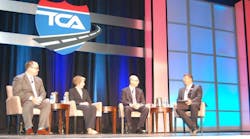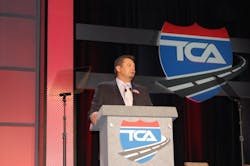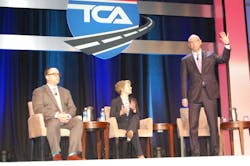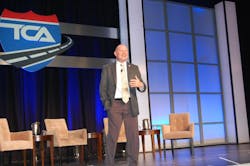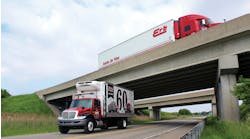NASHVILLE. The final day of the 2017 Truckload Carriers Association (TCA) annual convention tackled major industry topics, touching on the outlook for the U.S. freight market, examining the potential timeline for automated trucks, and how to attract more women into trucking’s ranks, while announcing several major awards – including those recognizing the “Best Fleets to Drive For” in North America as well as one truck driver’s singular act of heroism.
For starters, Rob Penner – president and CEO of Bison Transport, based in Winnipeg, Manitoba, Canada – will become TCA’s chairman for 2017-2018. Penner, who began his career in trucking as a driver in 1984, joined Bison in 1991; steadily moving up its executive ranks to become vice president of operations in 1998 and then president and CEO this January.
“Big change is upon our industry,” he noted in his acceptance speech here at the convention. “We need to decide if we’re going to be the ‘truck’ or the ‘trailer’ as we move forward; do we follow a path that others choose as the ‘trailer’ or do we make our own path as the ‘truck,’ putting our industry at the front of the line to lead [so we] can tell our story, over and over again.”
Penner said TCA is going to form a “strategic task force” that will research issues affecting productivity, profitability, and the movement of freight across North America that will be turned into a position paper designed to back up TCA policies.
“Today, it appears we are trapped spending the majority of our face time with lawmakers and regulators talking about what we don’t want,” he explained. “What we need is for them to give us time to talk about what we stand for, not what we stand against.”
Penner also chaired a special panel discussion shortly after his acceptance speech to look into one of the industry’s future issues: the automated truck. Industry experts on that panel included: Thomas Balzer, president and CEO of the Ohio Trucking Association; Kary Schaefer, general manager of marketing and strategy for Daimler Trucks North America (DTNA), and Michael Cammisa, vice president of safety policy and connectivity for the American Trucking Associations (ATA).
Blazer believes that while the industry may start to see semi-autonomous trucks capable of operating themselves in certain situations with a human driver aboard in 10 to 15 years, fully autonomous trucks without human drivers probably won’t be deployed for many decades.
“The big issue is the ‘Hollywood glamour’ vision of autonomous trucks and the reality,” he said. “There’s a huge acceptance level we need to go through as a society about the safety and efficiency of autonomous trucks.”
Schaefer noted that DTNA’s semi-autonomous “inspiration truck” still requires a human driver aboard because there are still many complex operating situations machines, no matter how highly developed, are ready to handle yet.
“This [autonomous] technology can follow a set course, keep the truck in its lane, and make sure it doesn’t hit the car in front of it,” she explained. “When you add in changing lanes, navigating on- and off-ramps, the full capability of [autonomous] technology has yet to be determined.”
Cammisa also pointed out that there is a “lack of a unified national approach” to the policies and regulations that will be needed to allow autonomous trucks to operate on U.S. roads. “And there is no one-size-fits-all policy solution when it comes to this technology, either,” he stressed.
Moving back to more near-term issues, Eric Starks, president of research firm FTR Transportation Intelligence, provided an outlook for the U.S. freight market. He said while there are some near terms worries about whether the U.S. will get involved in trade battles, which would severely crimp freight activity, so far at least all the economic metrics he follows – from rising manufacturing activity, more housing starts, and falling inventories – are pointing in the right direction.
As a result truck freight rates “are starting to turn up” though they remain “stagnant” compared to last year, Starks said. Ultimately, he believes rates should increase 4% by 2018, with “strong upside potential” for an even higher uptick in rates when the electronic logging device (ELD) mandate goes live in this December.
The Women In Trucking (WIT) organization also hosted a panel discussion at TCA focused on what fleets can do to attract more women not just into truck driving jobs but into management positions within transportation companies.
Ellen Voie, WIT’s president and CEO, moderated the session featuring several top female executives from trucking companies and an equipment OEM: Karen Smerchek, president and owner of Veriha Trucking Inc.; Sherri Garner Brumbaugh, president of Garner Trucking Inc.; Amy Boerger, vice president of the North American engine business for Cummins Inc.; and Lisa Quinn Pate, president and chief administrative officer for U.S. Xpress Enterprises.
Tim Hindes, CEO of Stay Metrics, also served on the panel and noted that nearly two years ago his firm began analyzing its motor carrier data by gender and found that 7.3% of the drivers employed by the fleets Stay Metric tracks are female. “That’s up a percentage point from where we were at last year,” he said.
Hindes added that the average age of female truck drivers parallels that of their male counterparts – around 52 – but that female drivers are 10% more likely to stay at a particular carrier than “job hop” when compared to male drivers. Also, “home time does not come up with women” as a “core predictor” of retention as it does with male drivers, he noted.
All the female executives on the panel agreed that attracting more women into the industry must start at a young age – even the elementary school level – with mentoring and encouragement to help younger women “get out of their comfort zone” and realize they are more than capable of handling any number of transportation jobs.
Cummins’ Boerger added that having more females in executive positions serves as role models to help attract and retain younger women into the transportation business. She noted that 22% of Cummins’ engineers, 22% to 25% of the company’s managers, and two out of its 10 board members, are women. “When you look up your leadership and see many women in such roles, that demonstrates what your opportunities are,” she said.
TCA and its partner CarriersEdge also unveiled the overall winners of the 2017 “Best Fleets to Drive For” contest. The Best Overall Fleet in the small carrier category is Grand Island Express of Grand Island, NE, while Canada’s Bison Transport won the Best Overall Fleet for the large carrier category.
This is the sixth consecutive time that Grand Island Express has landed in final “Top 20” Best Fleets to Drive For, from which a winner is picked. With 143 drivers/owner operators, the carrier focuses on adopting new technology. For instance, it now conducts monthly driver meetings via WebEx so drivers can call in or join via mobile app if they can’t attend in person – a practice fairly common among larger carriers, but unusual in trucking firms.
Bison Transport has placed in the Top 20 for seven of the nine years since the Best Fleets program was initiated. This year, recognizing a demographic shift among its drivers, Bison added a new, entry-level program specifically for team drivers. It also expanded the communication "touch points" during its on-boarding process for all drivers, which helps people get up-to-speed more quickly.
TCA also recognized a moment trucking heroism at its convention by awarding Daniel Sieczkarski, a driver for Tulsa, OK-based Melton Truck Lines, Inc., as its 2016 Highway Angel of the Year.This award, now in its 20th year and sponsored by EpicVue, honors truck drivers who have selflessly helped others while on the job. Sieczkarski won this award for his heroic actions on April 18 last year along I-10 near Brookshire, Texas, just outside of Houston, when he helped rescue a fellow truck driver trapped by rising floodwaters.
After several failed rescue efforts, Sieczkarski donned a life vest himself, swam out to the stranded driver's vehicle, and helped pull him to safety.
The TCA also bestowed its Past Chairmen’s Award on Tom Kretsinger, Jr., chairman of the board and CEO for American Central Transport (ACT) of Liberty, MO, who could not attend this year’s conference due to health issues. Instead, the organization held a special dinner for Kretsinger his hometown of Kansas City in his honor.
Kretsinger originally worked for his family’s law firm upon passing the Missouri bar exam in 1981 before joining ACT in 1998. A strong advocate for driver-facing in-cab camera systems, Kretsinger served as TCA’s chairman from 2013 to 2014, is a past chairman of the Missouri Trucking Association, and serves as the vice chairman of ATA’s labor and regulatory policy committee.
The Professional Truck Driver Institute (PTDI) presented its Lee J. Crittenden Memorial Award at TCA to Chris Antonik, the department chair of the commercial transportation program at Delaware Technical Community College. The award highlights those who go above and beyond in service of PTDI’s mission to train the next generation of truck drivers. PTDI currently has certified entry-level training courses at 57 schools in 19 states, Canada, and Germany.
Antonik, who began his career in the trucking industry as a tractor-trailer driver after serving in the U.S. Air Force as a fire protection specialist, advises, visits, and evaluates other truck driver training programs for standards compliance for PTDI.
